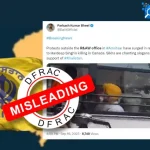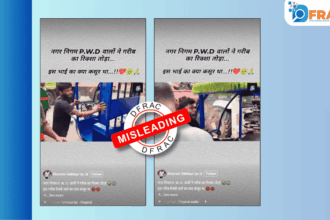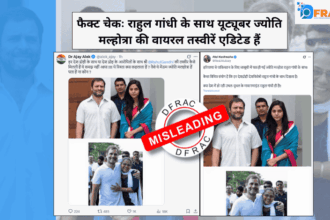Introduction
Music is one of the purest forms of art, having potential to heal, inspire, and revitalise the human being. But in today’s era, music is being used as a tool to spread hatred and promote animosity among religious communities. Spreading hatred and sowing the seeds of antipathy through music is an ongoing trend on the Internet. The right-wing party’s entry into the democratic system has significantly increased the popularity of Hindutvaadi, or Hindutva pop music, in our society. In this exclusive DFRAC report, we are going to provide an in-depth analysis of this new tool for spreading hatred online.
In this report, we will cover the following points.
- Hindutva Pop music
- The pattern of this music
- Singers who gained fame through Hindutva Pop
- Weaponizing music to target other communities
- Music nationalistic songs viewed by Youngsters
- Trigger communal clashes and violence:
- Atmosphere of Religious Polarisation
- Conclusion
Hindutva Pop Music-
Hindutva pop music is a growing trend on social media, especially YouTube. It is completely based on Hindutva, an ideology that finds Hinduism superior to the rest of the world. This is a peculiar genre of music that has been found to escalate anti-sentiments and promote bloodshed and violence in society. It came onto the scene under the reign of the RSS; it’s an amalgamation of religion and politics and successfully generates feelings and notions of prejudice and conservatism among citizens.
The Pattern of Hindutva Pop Music:
The music is also known as saffron pop. Its essential components are poorly matched lyrics filled with hate and provocative remarks, repetitive musical rock beats, and words such as gaddron, and kaat Dena (cut down), which can be heard in all the Pop songs of this genre. Hindutva pop songs have become a ubiquitous trend at all the Hindu festivals these days. All of these songs convey a strong Hindutva message of hatred and bigotry.
Singers who gained fame through Hindutva Pop:
In today’s scenario, there are several singers who have gained immense popularity through this new tool. Most of the singers belong to the middle class status and have rural backgrounds.
Laxmi Dubey

She is a staunch follower of Hinduvta and a YouTube sensation these days. Her songs have received millions of views on YouTube and are capable enough to inject fear into other communities. According to her bio, the ultimate goal of her life is to serve Hindutva and propagate the Hindutva ideology among youngsters. She has more than 371K subscribers on her official YouTube Channel .
Her songs ‘Har Ghar Bhagwa Chhayega 2, Har Ghar Bhagwa Chayyega 3, and ‘Bhagwa Lekar Aaye hai’ are highly acclaimed on the Internet.
Lyrics of her songs signal her intention to attack other communities that try to intervene in Hinutva Raaj.
She has more than 3.7 Million followers on her YouTube channel. With this substantial number of followers, the account manages to gain a large number of views on her videos on her songs. We analyzed that her channel received around 16 Million views over the period of Dec, 2021 to May, 2022.

Upon further investigation, we came to know that her top-viewed videos resonated with the topic of “Har Ghar Bhagva Chayega”. She uploaded four videos over a period of time on the topic of “Har Ghar Bhagva Chayega” and received a collective total of 17.7 million views. With these peculiar videos, she earns a pretty decent amount of income. Her estimated earnings would be in the range of $4.4k–35.3k USD on the most viewed videos.

Ved Vyas

He hails from Bikaner, one of the most controversial Hindutva pop singer. He is the president of right-wing youth in Bikaner. He has around 12k followers on his official Instagram account. It simply indicates his fame and charm among Hindu youth.
His song ‘Jag Uthe Hai Soye Hindu, released a year ago, has received more than 1 million views on YouTube.
‘Pakistan Nhi Hoga’ song evokes implied feelings of extremism and communalism in Hindus across the country. ‘Hindu Jagane Ayya Hu’ has remained one of the most celebrated songs of his career, having more than 10 million views on YouTube.
Due to his popularity as a Hindutva singer, he has received death threats from a Pakistani terrorist organization over his hate statements against Kashmir and Pakistan on social media. According to some media reports by Dainik Bhaskar, he has been threatened twice.
In first report, it was stated that a spokesperson of Tehreek-e-Taliban, wrote in a threatening message that he is issuing hate statements against Kashmir and Pakistan on social media and the words “we can see you”.
Whereas, the second report reveals: “Ved Vyas, city president of Bharatiya Janata Yuva Morcha, has once again received threat from Pakistan. For the second consecutive day, messages from Pakistan have threatened to kill him. Threatening messages have been sent to Ved Vyas for the second consecutive day, in which the slogan of Khalistan Zindabad has also been written. Along with this it is written that if you do your politics but do not bring Pakistan and Kashmir in between”.
Kavi Singh

Kavi Singh, entered the music industry by promoting Hindu-Muslim brotherhood but changed the theme of her music after some time. She has 1 million subscribers on her official YouTube channel. As per the description of her YouTube channel, this channel’s motive is to unite India and cover the length and breadth of the country. We believe After Silence is closest to expressing the inexpressible feelings through its music,” but most of her songs resonate with the theme of ancient Hindu temples, demolished by Muslim rulers to build mosques in the ancient period.
A brief investigation of her YouTube Channel reveals that her channel has held tremendous viewership, with over 198 Million views since the beginning of her official channel on 9th March 2019.

Dhara 370 is the most popular song according to her YouTube channel. The word Gaddron is frequently used in her song. The word indicates other communities except Hindus. Ab Gaadaron ki Khair nhi and ‘gaddron ki aankhon mein paani hai are the most repetitive phrases in this song. The estimate of earnings of her song ranges between $17k to $135K USD.

Sandeep Chaturvedi

Another popular Hinduvaadi singer in the Hindutva Pop scene, having over 4k subscribers on his official YouTube channel. He started his career as a devotional singer but established himself as a nationalist revolutionary singer in the present scene. The lyrics of his songs are structured in a way that can directly provoke and promote anti-sentimental content against Muslims. Words and Phrases such as Mandir todh Masjid and Gyanvapi are used extensively in his songs.
Weaponizing music to target other communities:
Hindutva Pop singers are using music as a weapon to target other communities. Hate imagery (sticks and swords) and themes such as the demolition of Babri Masjid, Gyanvapi, Hindu suffering in ancient times, and the time for action have been deployed by the singers to attack several religious communities explicitly. The anti-Muslim content employed in these hate songs violates several laws under the provisions of the Indian Penal Code.
The collages below demonstrate how avidly these Hindutva pop songs are circulated on social media platforms.



Music nationalistic songs viewed by Youngsters:
The lyrics of Hindutva pop music have deeply affected the minds of youth. Youngsters feel that a sudden rush of energy has been delivered into their bodies that sparks aggression and indignation. Ultimately, it helps in developing fanatical and rebellious attitudes towards other communities. Here’s a collage showing most popular songs of these Hindutva Pop singers.

Trigger communal clashes and violence:
Incendiary and provocative lyrics embedded in these songs are like adding fuel to the fire. Hindutva pop songs are usually played during religious and political celebrations, which trigger communal clashes and violence among several religious groups in society. According to some media reports, it has repeatedly caused violent riots on the occasion of Hindu festivals like Hanuman Jayanti and Ram Navami.
Website Jagran published a report on March 31, 2023 with the Headline: ” Ram Navami Festivites Marred With Clashes In Delhi, Gujarat, Bengal; Deaths In MP, Maharashtra And Rajasthan“. In this report, Jagran revealed: “Several incidents of stone pelting on Ram Navami processions and altercations over miscreants playing loud music outside mosques were reported”.
Another news website, NDTV published a news article on April 3, 2023 with the headline: “BJP MLA Injured As Clashes Erupt Again During Ram Navami Rally In Bengal“. In this news article, NDTV disclosed: “The Ram Navami procession played loud music with DJ and some people carried swords in front of a mosque, police sources told NDTV, adding the rally started late and beyond the permitted time”.

Atmosphere of Religious Polarisation:
Since the arrival of pop music, the social atmosphere has been surrounded by tension and chaos. The possibility of bloodshed and violence has significantly increased. Hindutva pop music is creating polarization among communities.
Conclusion :
There are many ways to spread hate, but using music as a tool in the context of hate speech on online platforms is quite prevalent. In this report, we have presented a brief analysis of Hindutva pop scene and its influence in the society along with exploring the online popularity of some well-known Hindutva pop singers who are actively promoting hatred by disguising themselves as religious performers.
Hindutva Pop music is becoming more popular day by day. This music has become an integral part of all social media platforms, leaving profound effect on Young and sensitive minds . It should be restricted as soon as possible.






